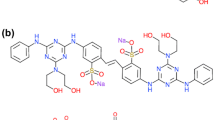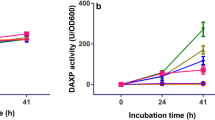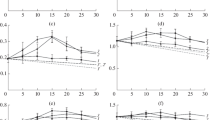Summary
Chemical analysis of pellicles ofAcetobacter xylinum grown in cultures containing increasing amounts of Calcofluor White or Congo Red shows that the inhibition of cellulose formation by both direct dyes has two aspects, internal and external. Internally, each dye seems to act as a general cell poison, although not a strong one. Externally, each dye interrupts cellulose microfibril assembly by forming a complex with previously synthesized polysaccharide(s). Both effects contribute to diminution of cellulose production.
The polysaccharide(s) which forms a soluble complex with Congo Red external to the cell may be isolated by dilution. It is a homoglucan that yields cellobiose, cellotriose and possibly cellotetrose after partial acid hydrolysis. The glucan is hydrolyzed at the same rate as bacterial cellulose by glusulase to yield glucose. It contains little or no ninhydrin-positive material. Observations by electron microscopy show that the glucan is fibrillar. Heating the precipitate in 1 M NaOH for 10 minutes at 100 °C dissolves more than three quarters of the substance but does not alter its ultrastructure or composition. No discrete reflections are observed by powder X-ray diffraction. The foregoing results are consistent with the conclusion that Congo Red (and presumably Calcofluor White) interrupts the normal, extracellular association of previously synthesized 1 → 4-β-glucans by forming a soluble complex with a fraction of these glucans. The interruption of the association prevents the formation of the microfibril.
Similar content being viewed by others

References
Braun, G., 1943: Cellobiose: α-Cellobiose Octa-acetate. Collected Volumes of Organic Syntheses11, 122–126.
Benziman, M., Haigler, C. H., Brown, R. M., Jr., White, A. R., Cooper, K. M., 1980: Cellulose biogenesis: Polymerization and crystallization are coupled processes inAcetobacter xylinum. Proc. Natl. Acad. Sci. U.S.A.77, 6678–6682.
Colvin, J. R., Chéné, L., Sowden, L. C., Takai, M., 1977: Purification and properties of a soluble polymer of glucose from cultures ofAcetobacter xylinum. Canad. J. Biochem.55, 1057–1063.
—, 1980: The mechanism of formation of cellulose-like microfibrils in a cell-free system fromAcetobacter xylinum. Planta (Berl.)149, 97–107.
—,Witter, D. E., 1980: On the inhibition of cellulose biosynthesis by coumarin. Plant Science Letters18, 33–38.
Haigler, C. H., Brown, R. M., Jr., Benziman, M., 1980: Calcofluor White ST alters thein vivo assembly of cellulose microfibrils. Science210, 903–905.
Herth, W., 1980: Calcofluor White and Congo Red inhibit chitin microfibril assembly ofPoterioochromonas: Evidence for a gap between polymerization and microfibril formation. J. Cell Biol.87, 442–450.
Hestrin, S., Schramm, M., 1954: Synthesis of cellulose byAcetobacter xylinum. 2. Preparation of freeze-dried cells capable of polymerizing glucose to cellulose. Biochem. J.58, 345–352.
Joseleau, J.-P., Chambat, G., Chumfritazi-Hermoza, B., 1981: Solubilization of cellulose and other plant structural polysac-charides in 4-methylmorpholine N-oxide: An improved method for the study of cell-wall constituents. Carbohydrate Res.90, 339–344.
Montezinos, D., Delmer, D. P., 1980: Characterization of inhibitors of cellulose synthesis in cotton fibers. Planta (Berl.)148, 305–311.
Quader, H., 1981: Interruption of cellulose microfibril crystallization. Naturwissenschaften68, 428–429.
Schnepf, E., Deichgraber, G., Herth, W., 1982: Development of cell wall appendages inAcanthosphaera zachariasi (Chlorococcales): Kinetics, site of cellulose synthesis and of microfibril assembly and barb formation. Protoplasma110, 203–214.
Sundaresan, R. V. S., Kimmins, W. C., 1981: Effect of coumarin on the synthesis and composition of cell walls inPhaseolus vulgaris (L). Ann. Bot.47, 283–285.
Valla, S., Kjosbakken, J., 1981: Isolation and characterization of a new polysaccharide from a cellulose-negative strain ofAcetobacter xylinum. Canad. J. Microbiol.27, 599–603.
Wood, P. J., 1980: Specificity in the interaction of direct dyes with polysaccharides. Carbohydrate Research85, 271–287.
Author information
Authors and Affiliations
Rights and permissions
About this article
Cite this article
Colvin, J.R., Witter, D.E. Congo red and calcofluor white inhibition ofAcetobacter xylinum cell growth and of bacterial cellulose microfibril formation: Isolation and properties of a transient, extracellular glucan related to cellulose. Protoplasma 116, 34–40 (1983). https://doi.org/10.1007/BF01294228
Received:
Accepted:
Issue Date:
DOI: https://doi.org/10.1007/BF01294228



